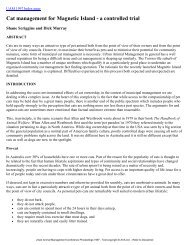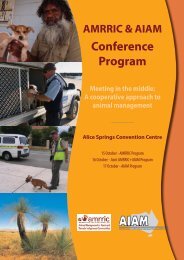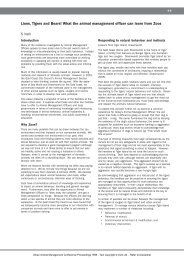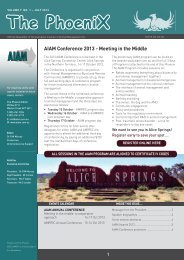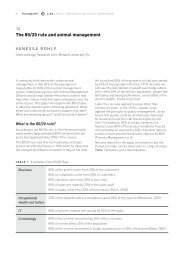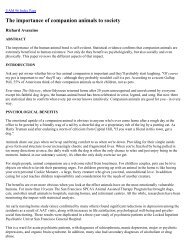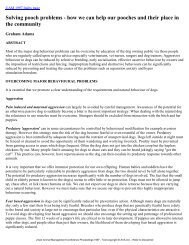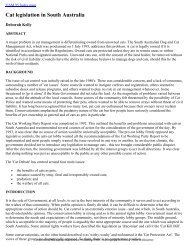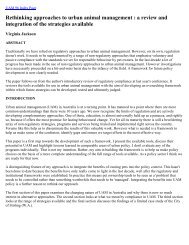Proceedings OF ThE - Australian Institute of Animal Management Inc
Proceedings OF ThE - Australian Institute of Animal Management Inc
Proceedings OF ThE - Australian Institute of Animal Management Inc
You also want an ePaper? Increase the reach of your titles
YUMPU automatically turns print PDFs into web optimized ePapers that Google loves.
70 <strong>Proceedings</strong> 2012<br />
AIAM Annual Conference on <strong>Animal</strong> <strong>Management</strong><br />
13<br />
Governance and Strategic Planning for <strong>Animal</strong> <strong>Management</strong><br />
– how to link it all up<br />
Shane Scriggins and Dick Murray<br />
Sunshine Coast Council, Queensland<br />
President AIAM<br />
A strategic plan for animal management needs<br />
to be more than just an operational plan. While a<br />
check list <strong>of</strong> things that need doing (in an operational<br />
sense) may be a very good thing to have, such a list<br />
does not constitute a strategic plan. A strategic plan<br />
does however need to include operational matters,<br />
but it should be more than this. It must, in a technical<br />
sense, be a comprehensive statement <strong>of</strong> governance<br />
compliance. To achieve this objective, a strategic<br />
plan needs to successfully describe the enabling<br />
mechanisms behind operations as well as it does<br />
the operations themselves. In this day and age, a<br />
strategic plan should also demonstrate a dynamic<br />
capacity to accommodate anticipated (and perhaps<br />
significant) changes in an operating environment.<br />
The two principal users <strong>of</strong> Local Government<br />
Strategic <strong>Animal</strong> <strong>Management</strong> Plans are the<br />
Councils themselves and their clients (i.e. residents,<br />
visitors, industry and special interest groups etc). To<br />
be meaningful for both <strong>of</strong> these user groups, Strategic<br />
<strong>Animal</strong> <strong>Management</strong> Plans need to satisfactorily<br />
explain the ”why” and the “how” <strong>of</strong> Council’s<br />
approach to <strong>Animal</strong> <strong>Management</strong> as thoroughly as<br />
they explain the “what” and the “when”.<br />
Good Strategic <strong>Animal</strong> <strong>Management</strong> Planning<br />
requires, perhaps before all else, a comprehensive<br />
“user friendly” format. There is no advantage in<br />
having a strategic plan that does not “work” at the<br />
community level. Such plans need to be clearly<br />
structured, easily understood and readily available<br />
for community review and comment.<br />
Introduction – What is strategy?<br />
The purpose <strong>of</strong> a Strategic Plan is to determine<br />
direction. Johnson and Scholes 1 define strategy as:<br />
“the direction and scope <strong>of</strong> an organisation over<br />
the long-term: which achieves advantage for the<br />
organisation through its configuration <strong>of</strong> resources<br />
within a challenging environment, to meet the needs <strong>of</strong><br />
markets and to fulfil stakeholder expectations”<br />
In other words, strategy is about direction,<br />
scope, advantage, resources, environment and<br />
stakeholders.<br />
Developing a business strategy is not a new concept<br />
in the corporate world, without them, surviving the<br />
recent global financial crisis (GFC) would have been<br />
an unlikely scenario for many. For local government<br />
however, their vulnerability to the GFC was less<br />
challenging because “market choice” is not an option<br />
for its customers. Given this scenario, has local<br />
government positioned itself to navigate through a<br />
crisis and has strategic business planning been a<br />
priority or has it slipped under the radar?<br />
If the answer is “slipped under the radar do not<br />
despair, the tide is beginning to turn. 2009 saw in<br />
Queensland the introduction <strong>of</strong> a dynamic piece <strong>of</strong><br />
legislation the “Local Government Act 2009”. This<br />
Act was dynamic in that prescriptive legislation,<br />
once an iconic beacon for all things legal had been<br />
removed, and was replaced with a “principles based”<br />
drafting platform. For the first time since Federation,<br />
local government had a statutory obligation to<br />
apply transparency, democracy, good governance,<br />
sustainability and ethics in its decision making<br />
process.<br />
Why have Strategic <strong>Animal</strong> <strong>Management</strong><br />
Planning in Local Government?<br />
To encourage local government compliance with<br />
the new Act, the Queensland Parliament legislated<br />
that local government must develop and implement<br />
Community Plans, plans built in collaboration with<br />
and driven by its community. Parliament rightly<br />
believed that the liveability <strong>of</strong> a community or a<br />
local government area is generally driven by the<br />
cumulative decisions <strong>of</strong> local government and its<br />
residents. A Community Plan was viewed as the<br />
vehicle by which Council and the community could<br />
develop a strategic direction for the region, improve<br />
relationships, develop long term partnerships and<br />
build on that capacity to help maintain and enhance<br />
the vitality, sustainability and liveability <strong>of</strong> the local<br />
government’s area.<br />
1 Exploring Corporate Strategy 1st Paperback Edition 1998



